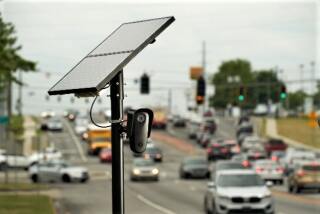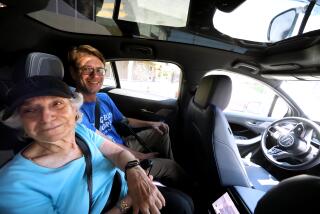SCIENCE / MEDICINE : Robots Hold the Key to New York Pay Phone System : Technology: Thousands of coin box openers have to be sorted every day. The task is accomplished through a complex mechanical ballet.
- Share via
NEW YORK — Southern California has its automobiles; France has cafes, and Hong Kong, open-air markets.
New York? Public telephones.
There are about 150,000 pay phones in New York state--about the number operated by Pacific Bell throughout California. In New York, however, most pay phones are concentrated in a much smaller area, south of Albany. New York Telephone, for example, has 93,000 pay phones in that area.
Presiding over this pay phone empire is Robert E. Bellhouse, general manager of public communications at New York Telephone. “I get visitors (from other telephone companies) from around the world, about every two weeks,” he said. “They all walk away shaking their heads in amazement, because of the density of the phones, the sheer magnitude of the operation.”
Like other telephone companies across the country, it has a different key to open the coin box of each of its pay phones--a security policy held over from the days of the Bell System. Fetching and distributing keys in a sequence matching the routes driven by coin collectors, and then storing the keys after the coins were collected, used to be full-time work for 15. It was tedious work that quickly wore out even patient employees.
But New York Telephone seems to have finally found the ideal workers for the job: robots. Every day, the mundane task becomes the basis for a mechanical ballet in a building in mid-Manhattan. It is the only system of its kind, according to company officials and experts in the field.
The choreographer for this digital troupe is a powerful mainframe computer operated by Nynex, the holding company of Bell-affiliated telephone companies in New York and New England. Pay phones fill up with coins at different rates, and the Nynex computer keeps track of these rates for every pay phone in New York state.
A day or so before a collection, a supervisor at New York Telephone tells the computer which areas should be emphasized for collection. Overnight, based on that information and its own internal records, the Nynex computer generates a list of pay phones that should be emptied, and their corresponding key numbers.
These lists are then transmitted to two personal computers, which are the heart of the robotic system. The PCs keep track of all of the keys, which are stored in trays of 300, neatly stacked against a wall. The PCs also make sure that keys are fetched in an order corresponding to routes driven by coin collections. A route may encompass 50 pay phones in a less-populated area, up to 600 or so in parts of Manhattan.
About 3 p.m. the day before the collection, the robots go to work. Two tall robots move smoothly back and forth on tracks, pulling out trays and delivering them to nine smaller robots mounted on tables, which deftly pluck the keys out of the trays and place them on rods.
Each of the table robots has a tray on either side. When it finishes with one tray, it turns immediately to the other, while a track robot replaces the spent tray with the next one the table robot will need.
The table robot makes sure it has the right tray by holding the first key it selected in front of video cameras, which read an identifying number stamped on the key. Scattered sensors tell the robots when there is a tray in place, when they have a key or tray in their hands, and when the rod is in place to accept keys.
The two track robots split responsibility for handling the array of trays, but if a tray is out of the reach of one, the other will fetch it and hand it over. In this synchronized operation, no one is ever idle or uncooperative.
“It’s more fun than Lionel trains on Christmas morning,” said Robert E. Bellhouse, general manager of public communications at New York Telephone.
After one of the smaller robots has placed all the keys for a route on the rod, a human attendant quickly transfers them to a shackle carried by a collector. By this time, route instructions are waiting for the collectors, having been printed by yet another computer system, based on the original lists from the Nynex computer.
The robots distribute as many as 6,000 keys a day but the system is not yet fully on-line. When it is, sometime this summer, the number should be 9,000, according to Robert Fergesen, the engineer at New York Telephone who worked on the software that controls the robots--all 50 programs of it.
Keys used one day are returned the next, and by late morning the robots start returning them to trays. The collected coins come in along with the returned keys. On an average day the take is about $650,000, a tidal wave of silver that splashes through 23 high-speed counting machines, specially designed and built for New York Telephone.
In the afternoon, the robots start fetching keys for the next day’s collection, and the cycle starts all over again--except on Saturday. The robots have Sundays off.
More to Read
Inside the business of entertainment
The Wide Shot brings you news, analysis and insights on everything from streaming wars to production — and what it all means for the future.
You may occasionally receive promotional content from the Los Angeles Times.










